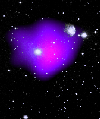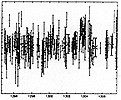For Educators

The RXTE Learning Center presents:
Tour the ASM Sky!
Note: This was written before RXTE was decomissioned. We still provide data sets to use for these lessons, even though we no longer have live data.
Have you ever wondered what is way out in space, say 100 light years away? Well, X-rays are one of the keys that can unlock these far off mysteries for us. They can give us a view of the Universe that is very different from what our limited eyes can perceive. The human eye sees only a small range of the wide energy spectrum of light.
While we cannot see X-rays ourselves, we can use things like CCD cameras to count photons of X-ray light and computers to take those photon counts and translate it electronically into something we can see.
|
It is analogous to when we go to the doctor's office for an X-ray. X-rays are shot through us and our bones, skin, and muscles absorb some of the X-rays leaving the rest to be captured by X-ray film placed on the other side of us. We may not be able to see the X-rays directly, but when the film is developed, we are able to see the picture the X-rays' presence created.
|
 |
What many people don't realize, is that many things in space emit light in a much wider range that we can see. This includes bands of light like Ultraviolet, Infrared (think about those night vision goggles you see in the movies), Radio (we listen to this every day), Microwave (like the oven we use to cook our food), and of course, X-rays.
![]() Because our atmosphere
absorbs X-rays (and lucky for us it does!), we put satellites in orbit and
point them towards things that we know to be emitting X-rays. When we
compare X-ray data to pictures taken at optical energies, we often get
very different views of the same object.
Because our atmosphere
absorbs X-rays (and lucky for us it does!), we put satellites in orbit and
point them towards things that we know to be emitting X-rays. When we
compare X-ray data to pictures taken at optical energies, we often get
very different views of the same object.
This image to the right shows three galaxies known as the NGC 2300 group, located about 150 million light-years from Earth in the direction of the northern circumpolar constellation Cepheus. The magenta, while false color, shows the X-ray light coming from this galaxy cluster. This X-ray information (from the satellite ROSAT) is superimposed over an optical image of the same area taken by the Hubble Space Telescope. We can see that these galaxies are immersed in a huge cloud of hot gas 1.3 million years in diameter. Astronomers estimate that the cloud has a mass equal to 500 billion times that of the Sun, and is at a temperature of about 10 million kelvins (about 18 million degrees Fahrenheit).
|  |
Tour the ASM Sky is meant to share yet another view of the Universe! The All-Sky Monitor (ASM) is an instrument on RXTE. It absorbs photons from far off objects too, only when the computer translates the data for us to see, it does it not in the form of photographs, but something called a light curve.
 |
A light curve is basically a graph of X-ray intensity over time. For example, peaks in the graph correspond to increased amounts of X-ray activity. By looking at light curves, we can look at the pattern of an object's X-ray emission, which in turn can tell us more about that object.
|
Tour the ASM Sky allows you to look at a map (like the one to the right) that shows the sources presently visible in the X-ray sky. You can click on any quadrant on the map and pull up "trading cards" about the objects in the quadrant. These trading cards will tell you a little about the object and allow you to access the data that the ASM has taken from these sources. You can choose to look at all the data taken about that object since the start of the RXTE mission, or at data as young as 3 hours old! There is also a list of all these X-ray sources that will give you similar options to the Map. This is convenient if you wanted to check on a particular source!
|
 |
 |
We also supply lesson plans for educators; this will help you to take real scientific data into the classroom!
|


